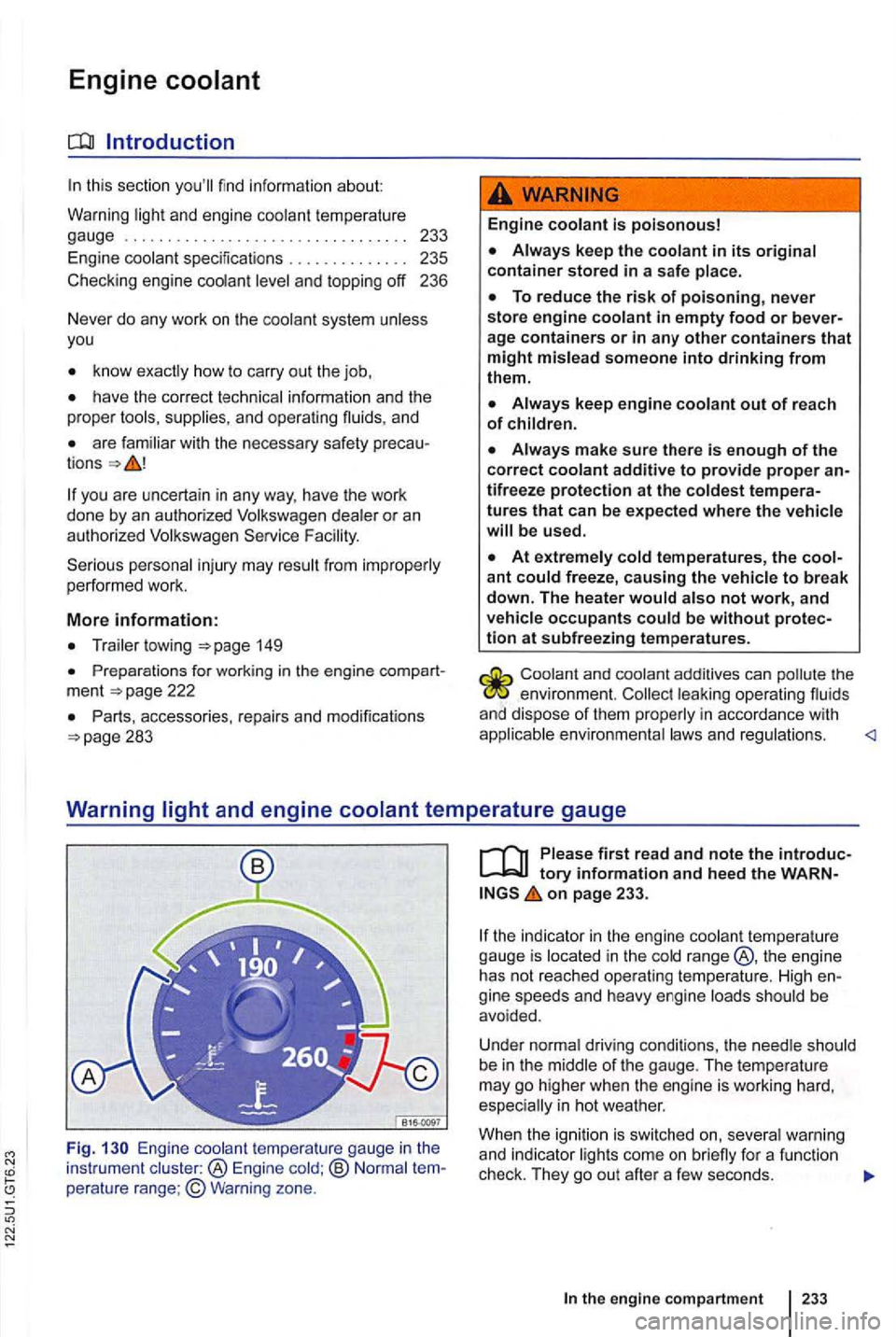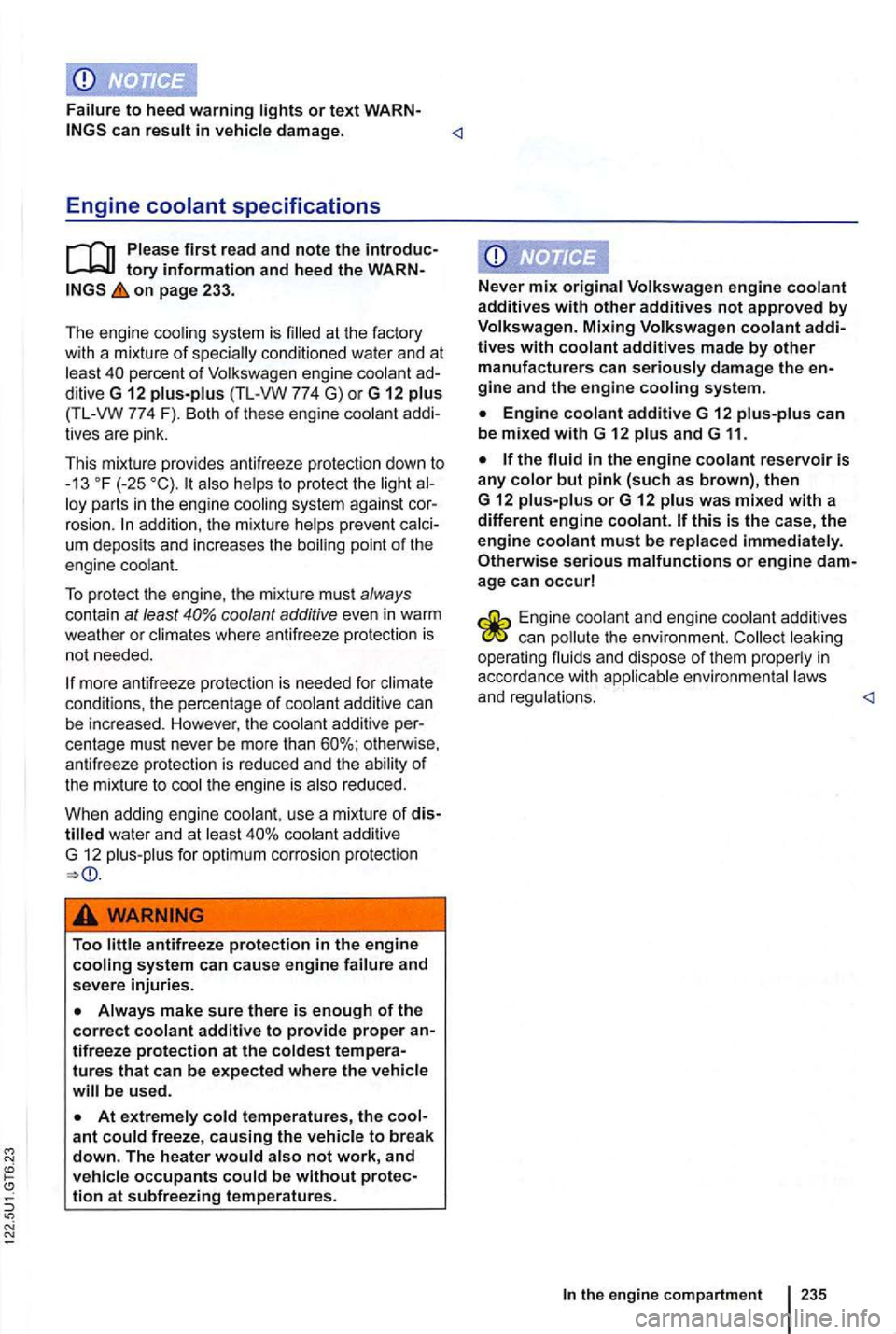Page 332 of 516

Engine
this section you'll find information about
Warning light and en gine coolant tempe rature
gaug e ................................. 233
En gine coolant spec ifica tions . . . . . . . . . . . . . . 235
Checking engine coolan t level and toppi ng
o ff 236
Ne ver do any work
on the coolant system unle ss
you
know exactly how to carry out the job,
have the correct technical inform ation and the
proper tools, supplie s, and operating fluids, and
are fa miliar with the necessary safety
you are uncertain in any way, have the work
done by an authori zed Volkswage n dea le r or an
a uth orized Volkswagen
in jury may
to wing =>page 149
Preparat ions for work ing in the engi ne page 222
Parts, accesso ries, repai rs and modifications =>page 283
Engine coolant is poisonous!
To reduce the risk of poisoning, never
store engine coolant in empty food or age containers or in any other containers that might mislead someone into drinking from them.
Always make sure there is enough of the correct coolant additive to provide proper tifreeze protection at the coldest tures that can be expe cted where the vehicle will be used .
At extremely cold temperatures, the ant could freeze, causing the vehicle to break down. The heater would also not work, and
vehi cle occupants could be without
Coolant and coolant additives can po llute the en vironme nt. leaking ope rati ng fluids
a nd dis pose of them properly in acco rdance with
applicab le environment al
Warning light and engine coolant temperature gauge
Fig.
perature range;© Warning zone.
first read and note the
on page 233.
the in dicator in the engine coolant tempera ture
gauge is located in the cold range @, the engine
h as not reached operating temperature . H igh
gi ne s peeds and heavy engine loads should be
avo ided .
Under normal driving con
ditions , the needle should
be in the middle of the gauge . The tempe ratu re
may go higher when the engine is working hard, espec ially i n h ot weather.
When
the ign ition is switched on, seve ra l warn ing and indicato r
the engine compartment 233
Page 334 of 516

Failure to heed warning lights or text WARN-can result in vehicle damage.
Engine coolant specifications
on page 233.
Th e engine cooling system is
loy parts in the engine cooling system against ros ion. addition , the mixture helps prevent
coolant additive even in warm
weathe r or climates where antifreeze protection is
not needed.
otherw ise ,
antifreeze protection is reduced and the ability of the mixture to cool the engine is also reduced.
When
adding engine coolant, use a mixture of tilled water and at least coolant additive
G 12 pius-plus for optimum corrosion protection
.
Too little antifreeze protection in the engine cooling system can cause engine failure and
severe injuries.
tures that can be expected where the vehicle will be used.
ant could freeze, causing the vehicle to break down. The heater would also not work, and vehicle occupants could be without
gine and the engine cooling syste m.
can pollute the environment. Collect leaking
operating fluids and dispose of them properly in
accordance with applicable environmental laws
and
regu lations .
Page 375 of 516
worn down.
,
chains can scratch or damage
recommends using coated snow chains.
Glossary of tire and loading terminology
on
page 258.
Accessory
weight
The combined weight (in excess of
those standard items which may be
of automatic trans miss ion,
power steering ,
power brakes, po
wer w indo ws, power
seats, radio, a nd heater , to
the extent
that these items are
equipment (whethe r in
or
indi cates a tire with a
shorter
for impro ved ste ering
response and better
on dry pavement.
Bead
The part of a tire made of wires,
wrapped or r einfo rced by
cords ,
w ith the shape and structure to en
sure proper fit to th e
rim .
Bead separation
A breakdown of the bo nd between
components in the bead.
276 maintenance
Carcass
The tire structure, except tread and
Cord
The strands of forming the
or inner
manufacturer for a tire of a
speci
fied size that has not been driv
en for more than a
Page 428 of 516

the engine
the engine of the vehicle with the good
battery that is providing help and let it run at idle
speed .
Turn on the ignition of the vehicle with the dead
b attery. the engine starts, wait 2 to 3 minutes
the engine does
not start within about seconds , turn off the tion and wait at least 1 minute ; then try again .
Removing the jumper cables
Before you remove the jumper cables. swi tch
off the headlights (if they are on) .
the vehic le with the dead batte ry , switc h on
t he heater fa n and the rea r window defroster. This
he lps
to m in im ize voltage spikes when the cables
a re disconnected.
With the engine running , remove the jumper
nected .
Disconnect the black (- ) cab le f rom the vehicle
wit h the dead battery .
Disconnec t the black (-) cable from the other
vehicle (vehicle with the good battery) .
Disconnect the red(+) cable from the other
Disconnect the red (+ ) cable from the vehicle
with the dead battery .
Close the battery cover.
Improper use of jumper cables when starting a vehicle with a dead battery can
cause the battery to explode , leading to
Always wear proper eye protection. Never
lean over the vehicle battery.
Attach the jumper cables in the correct
Never connect the negative cable from the
vehicle providing starting assistance to parts of the fuel system or to the brake hoses or brake lines.
Never
sistance.
Avoid electrostatic discharge in the may cause the hydrogen gas escaping from the vehicle battery to ignite.
Never jump-start a vehicle with a battery
that is damaged or frozen or that was frozen
and has thawed. The battery can explode.
Always the instructions of the jumper cable manufacturer.
Never connect the negati ve cable from the other vehicle directly to the negative terminal of the dead battery . The hydrogen gas from
the battery is explosive.
Never short out the battery terminals by connecting the positive(+) and negative
Practical tips 329